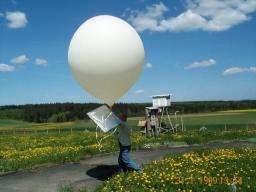Meteorological aids service
Meteorological aids service (also: meteorological aids radiocommunication service) is – according to Article 1.50 of the International Telecommunication Union´s (ITU) Radio Regulations (RR)[1] – defined as «A radiocommunication service used for meteorological, including hydrological, observations and exploration.»
- See also

Frequency allocation
The allocation of radio frequencies is provided according to Article 5 of the ITU Radio Regulations (edition 2012).[2]
In order to improve harmonisation in spectrum utilisation, the majority of service-allocations stipulated in this document were incorporated in national Tables of Frequency Allocations and Utilisations which is with-in the responsibility of the appropriate national administration. The allocation might be primary, secondary, exclusive, and shared.
- primary allocation: is indicated by writing in capital letters (see example below)
- secondary allocation: is indicated by small letters
- exclusive or shared utilization: is within the responsibility of administrations
However, military usage, in bands where there is civil usage, will be in accordance with the ITU Radio Regulations.
- Example of frequency allocation
| Allocation to services | ||
| Region 1 | Region 2 | Region 3 |
401-402 MHz METEOROLOGICAL AIDS
| ||
References / sources
- ITU Radio Regulations, Section IV. Radio Stations and Systems – Article 1.50, definition: meteorological aids service / meteorological aids radiocommunication service
- ITU Radio Regulations, CHAPTER II – Frequencies, ARTICLE 5 Frequency allocations, Section IV – Table of Frequency Allocations